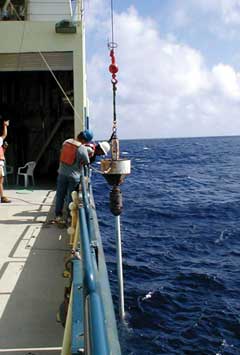|
NEWS NOTES — NEWS
Oceanography
Ancient ocean burps
 Thomas Marchitto, University of Colorado |
| A sediment core extracted from the ocean floor off the coast of Baja, Calif., indicates two “burps” of carbon dioxide were once released from a deep, stagnant part of the ocean. |
Researchers pulled buried treasure from the floor of the Pacific Ocean in the form of a sediment core. Details in that treasure chest are pointing toward a deep ocean source for what researchers are calling two ancient “burps” of carbon dioxide, a leading greenhouse gas, into Earth’s atmosphere.
The ocean has long been known to act as a reservoir, or sink, for some of that gas before it goes back to the atmosphere. That link has never been clearly observed. Now, however, Thomas Marchitto of the University of Colorado at Boulder and colleagues have traced the journey of the carbon dioxide from poorly circulated and deep, ice age ocean water to the atmosphere. The finding, reported June 8 in Science, could advance the understanding of ocean circulation and carbon dioxide cycles, as well as the role they play amid a changing climate.
Ocean circulation is thought to play a significant role in climate, although the details of the causes and effects have been debated. Complicating the picture is the difficulty in finding out how Earth’s oceans circulated in the past. Today, ocean circulation transports warm equatorial surface water as it travels toward the North Pole, where it becomes colder, saltier and heavier until it sinks. This deep water is then brought back toward the ocean surface at the equator by mixing, winds and tidal forces, and then flows north again — completing the circuit takes about a thousand years, according to contemporary measurements of radiocarbon in seawater. But the efficiency of the cycle is thought to be affected by changes such as melting sea ice, which researchers think slows circulation as it freshens polar surface waters (see Geotimes, November 2006).
In the sediment core, Marchitto found evidence showing that indeed, during the last glacial period, which ended about 10,000 years ago, Earth’s oceans had a sluggish circulation. “The study provides the strongest evidence to date that the glacial ocean contained some very poorly ventilated water somewhere in its depths,” wrote Ralph Keeling of the University of California at San Diego, in an accompanying paper published June 8 in Science.
Studying sediment cores for clues about past ocean circulation patterns is not a new idea. Researchers have previously sought to determine the speed of past ocean circulation by looking at the shells of tiny sea creatures called foraminifera, or forams, which preserve the isotopic signature of the carbon they absorb from seawater during their life. Deep-water-dwelling forams have lower signatures than those that dwell in shallower waters. By measuring the differences between surface- and deep-dwelling forams from the same layer, researchers previously teased out information about how efficiently the ocean circulated, down to about 2,800 meters (9,200 feet) deep. This turned out to be not that different from rates of today, Keeling wrote.
The core collected off the coast of Baja, Calif., however, tells a different story. This core preserved layers of sediment in such detail that it allowed the team to determine the age of the sediments by comparing the layers in this core to those in cores previously pulled from Greenland. Knowing the age of the forams, the team could determine when changes occurred in the radiocarbon content of the waters in which they lived.
The radiocarbon changes suggest that the deep, old and poorly circulated water welled up about 18,000 and 13,000 years ago, releasing stored carbon back into the atmosphere. The timing coincides with periods during the last deglaciation when atmospheric carbon dioxide levels spiked. The team was surprised to find that the movement of carbon in the ocean was so “clearly related” to the atmospheric carbon dioxide signal, says Scott Lehman of the University of Colorado at Boulder. “It seemed to clinch the argument,” he says.
The team plans to extract more cores so that they can map the geographical extent of this stagnant and deep carbon-rich water. That could prove difficult, however, as the deepest ocean doesn’t readily reveal its past because of difficulties in finding foram-rich sediments with the necessary detail, Lehman says. The basic framework for this study was already in place, but the discovery of a core with such clearly datable sediment bands was what made the study possible. “We got lucky,” he says.
Links:
"Conveyor belt shutdown not imminent," Geotimes, November 2006

 Subscribe
Subscribe


